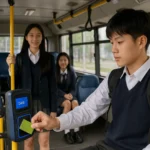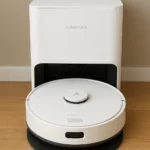Have you ever wondered how much high school students in Incheon pay for bus fare? Or why some families see noticeable savings once kids switch from elementary to high school? This article explains everything you need to know about student bus fees in Incheon—from elementary to high school.
High school student bus fare Incheon
When it comes to transportation, high school students in Incheon enjoy relatively affordable fares thanks to regional subsidies and fare policies aimed at supporting youth mobility. As of 2025, the standard bus fare for high school students in Incheon is 900 KRW when using a transportation card. This rate applies to both intra-city green buses and blue metropolitan buses within the Seoul Capital Area, including Incheon.
These fares are significantly cheaper than adult fares, which typically range from 1,500 to 1,800 KRW depending on distance and type of bus. The discounted student fare ensures affordability for young commuters who rely on buses daily to attend school, academies, or part-time jobs.
Why are fares discounted for high school students?
The Incheon Metropolitan City government actively supports youth by providing discounted or free public transportation options as part of a broader social welfare strategy. Here’s how it works:
-
Student age is verified via transport card registration, typically tied to a resident registration number.
-
Buses automatically apply student fare discounts, preventing students from needing to show IDs or ask drivers for lower rates.
-
Subsidies are coordinated through T-money or Cashbee card systems, which track usage and enable Incheon to audit and manage student fare expenses.
Case study: Incheon Science High School
As someone who commutes regularly from Yeonsu-gu to Incheon Science High School in Bupyeong-gu, I save nearly 30,000 KRW per month using my student card. In contrast, if I were charged adult rates, that total would jump to over 50,000 KRW monthly. That’s a tangible benefit for students, especially in multi-child households.
Tips for maximizing student fare benefits
-
Always register your transport card as a student card.
-
Avoid cash payments, as cash fares don’t offer student discounts.
-
Use transfer benefits wisely—within 30 minutes, transfers between subway and bus are free.
-
Renew student status annually if the card is not auto-updated.
-
Report lost cards immediately to prevent misuse and data loss.
These habits can help ensure students get every bit of the discount they deserve.
더욱 자세히 알아보려면 아래 버튼을 클릭하세요.
👉Incheon High School Student Fare Details👈
Elementary school bus fare
While high school students benefit from subsidized rates, elementary school students in Incheon often ride for free or at ultra-low fares. Typically, children under 12 ride buses for just 450 KRW with a registered child card—or completely free depending on the bus route and policy.
Why are younger students sometimes given free rides?
-
Encouraging school attendance by removing cost barriers.
-
Ensuring safety, as children using registered cards are traceable.
-
Reducing parental burden, especially in low-income households.
Most parents I’ve spoken with in the local PTA group mentioned that their elementary-age children ride buses for free on their daily commute to school or after-school programs.
Practical example: Jung-ang Elementary School in Namdong-gu
Parents from Jung-ang Elementary report that about 85% of students use a transport card loaded with child status. This gives them full access to free transfers and discounted travel across buses and the Incheon subway system. According to Mr. Kim, a father of two, this system saves his family around 70,000 KRW per year per child.
How to make sure elementary students get these benefits:
-
Apply for a child T-money or Cashbee card at convenience stores or online.
-
Register the child’s birthdate, which ensures proper fare classification.
-
Teach children how to use the card properly.
-
Keep a backup card in case of loss.
-
Monitor card usage regularly via T-money or Cashbee apps.
These steps ensure safety, savings, and system reliability for younger passengers.
더욱 자세히 알아보려면 아래 버튼을 클릭하세요.
👉Elementary School Bus Fare in Incheon👈
Elementary school bus fee
It’s important to distinguish bus fare from bus fees in the context of elementary schools. In many cases, “bus fee” refers not to public transportation but to private school shuttle services, which are common in Incheon’s densely populated neighborhoods.
These private buses often operate on a monthly subscription basis and are managed by schools or third-party vendors. Fees can range from 30,000 KRW to 100,000 KRW per month, depending on the distance, route complexity, and vehicle quality.
Why do parents opt for paid shuttle buses?
-
Direct-to-door service provides convenience and safety.
-
Supervised rides often include adult staff onboard.
-
Timely pick-up/drop-off, ensuring better scheduling for working parents.
For instance, Seo Elementary School in Seo-gu offers a shuttle service to outlying areas where public bus connections are inconvenient. According to a parent survey conducted last year, 70% of families use the paid shuttle, even if they live near a public stop, simply for the convenience and safety assurance.
Real-life scenario: Private shuttle from Songdo to Yeonsu Elementary
A private vendor offers a shuttle bus from the newly developed Songdo district to Yeonsu Elementary School for 80,000 KRW monthly. The bus features seat belts, air conditioning, and a staff member who manages student boarding. For working parents, the cost is worth the peace of mind.
Things to consider before subscribing:
-
Compare with public transit options—if accessible, public may be cheaper.
-
Check vehicle safety certifications.
-
Ask about refund policies in case of illness or vacation.
-
Ensure drivers have background checks.
-
Request a trial ride, especially for young or first-time riders.
Understanding the difference between public fare and private fees helps parents make informed choices based on convenience, budget, and safety.
더욱 자세히 알아보려면 아래 버튼을 클릭하세요.
👉Incheon Private School Bus Info👈
Conclusion
Whether it’s a 900 KRW swipe for a high school student, a free ride for a child, or a premium private shuttle, transportation in Incheon is thoughtfully tailored to suit the needs of students at every stage. The city’s structured fare system and multiple options reflect a deep commitment to affordability, accessibility, and safety.
As Nelson Mandela once said, “Education is the most powerful weapon which you can use to change the world.” But for education to be accessible, students must first be able to get to school. Incheon’s evolving student transport system helps ensure just that.
From free rides to affordable commutes and premium shuttles—there’s something for every family.






